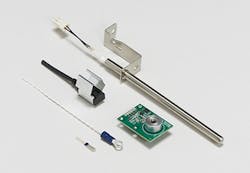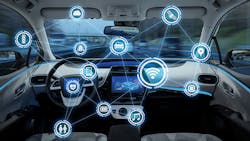Temperature is generally known as the most sensed physical attribute in the sensor world. A wide range of temperature sensors have been developed over the years, including negative temperature coefficient (NTC), thermistors, resistance temperature detectors (RTDs), thermocouples, thermopiles, and more recently, digital temperature sensors.
Each technology, which has its advantages and disadvantages depending on the application, desired temperature range, accuracy, and other parameters, continues to evolve. Designers and manufacturers are developing new materials and improved processes that allow for smaller, more accurate products as well as ones with increased operating ranges or other features desirable by today’s engineers.
1. Temperature sensors are available in a range of designs and form factors.
Though digital temperature sensors have been around since the 1970s, they’ve only recently become more popular in new designs. The original digital temperature sensors weren’t very accurate, required a special interface, and weren’t necessarily easy to use.
The digital revolution in the sensing industry has pushed manufacturers to develop new or improved products to address today’s need for small, accurate temperature sensors that utilize a standard digital interface with very low power requirements and are easy to use. On that front, TE Connectivity (TE), which is heavily involved in digital temperature-sensing arena, projects its digital temperature sensor products to grow at twice the rate of the overall industrial market.
In addition to growth in the traditional industrial marketplace for temperature sensors, a number of trends are accelerating the growth of digital temperature sensors, including:
The Internet of Things (IoT): The addition of intelligence to everyday devices dramatically increases the sensor content at a pace far beyond the general rate of market growth. Key areas that IoT is expected to impact include appliances like refrigerators, thermostats and the connected home, crop/livestock monitors, as well as industrial machinery as part of the Industrial Internet of Things (IIoT).
Conversion from analog to digital: The replacement of traditional analog solutions in the next generation of designs with primarily or full digital designs.
Mobile battery-powered applications: The growth of battery-powered applications for IoT and other applications. Digital temperature sensors can have very low power consumption since; generally, they’re put into a sleep mode and only active as needed. In addition, their small size is ideal, and these features make them attractive for energy harvesting as well as wireless applications.
Digital communications simplify designs: Digital data simplifies the electronic requirements and eliminates the need for bridge networks, op amps, analog-to-digital converters, and other associated hardware with traditional analog interface circuits. Moreover, digital data is connected directly to the processor unit or other devices without any further processing.
Electronics are becoming more bus interfaced: Many of the products we use every day—automobiles, smartphones, TVs, etc.—include one or more digital buses. I2C and SPI, two very popular digital protocols used for digital bus architectures, are standard protocols for many of today’s digital temperature sensors. Furthermore, these bus architectures allow multiple device addresses that make it possible to easily incorporate multiple sensors into a design.
Flexibility: Digital sensors can incorporate a range of features in their firmware, such as calibration information, ID tags, revision information, and much more. Also, firmware features can often be monitored in real time or updated as needed.
Accuracy: For a digital sensor, total system accuracy is exactly the same as the digital sensor’s accuracy. There’s no loss of accuracy due to bridge circuits and other hardware for the analog-to-digital conversion process. Analog systems typically allocate half of their accuracy budget to the sensor and the remaining half to the conversion circuitry.
Array of Applications
2. Temperature sensors operate in a variety of applications and environments.
The range of applications for digital temperature sensors is very broad and continues to expand. Some of the more popular applications include:
- Vehicle subsystems: Digital temperature sensors are the best value for non-critical subsystems like climate control, rain sensors, seat heating/cooling, and infotainment systems. The buses typically allow for up to 16 devices on one bus, support I2C or SPI protocol, are very small, low power and cost effective
- Building automation: Many of today’s designs can adjust for occupancy as well as compensate for external conditions such as outside air temperature and humidity. Sensors are used to monitor system performance as well as the performance of many system components.
- Intelligent factories: The IIoT is being utilized to monitor and adjust environmental conditions for personnel and equipment, monitor machine health, and measure workpiece condition. Digital sensors require less intelligence at each node for a lower overall installed cost, and multiple sensors on a single bus allow for data collection over large machines or workspaces.
- Wearables: From fitness and environmental monitors to products for remote healthcare, wearables have seen a dramatic rise in popularity. Digital sensors’ small size and low-power operation along with good accuracy and low cost make them ideal for today’s wearable designs.
- Food and drug: With very strict requirements for temperature monitoring from the farm to the market to the table, digital sensors are being utilized for monitoring food and drug storage and transportation as well as storage history. They’re also part of wireless cooking systems, as well as serving and salad-bar monitoring probes. Their high accuracy is important for fast, reliable monitoring and their low cost and digital output are ideal for wireless systems.
- Medical: Digital temperature sensors can be found in an array of medical applications, including wireless patient monitoring and central monitoring applications. Digital sensors allow for compact designs that reduce bedside clutter and improve patient comfort.
Food Temp-Monitoring App
One recent customer application that demonstrates much of what’s discussed above involves the ability to track temperature of food products used in a restaurant setting. Food distributors and restaurants are required by law to comply with many federal regulations that enforce strict monitoring of the temperature of most foods. Some of these regulations in the U.S. include The Code of Federal Regulations (CFR) Title 21, FSMA (Food Safety and Modernization Act), and HACCP (Hazard Analysis Critical Control Point).
3. Tracking hygiene ratings from source to consumer: Industry standards put heavy requirements on food businesses to track storage and processing conditions.
These regulations require constant monitoring and recording of food temperature during production, transportation, and packaging to ensure that the foods we eat are safe. A customer had an established product for tracking food processing, transport, and storage characteristics using analog technology. For their next-generation handheld battery-powered design, they needed improved sensor characteristics including the following:
- An expanded range of temperature operation to ensure that it would be adaptable to a range of food process checks.
- Small size, which would make it possible to sample thin and delicate food types.
- About 1 second of response time, which allows for rapid sampling and minimizes labor costs.
- High accuracy to accurately detect temperatures near critical points.
- Low power consumption—although not part of the stated specifications, this would help maximize battery life.
The best solution was a compact, stainless-steel food temperature probe with an integrated handle that included electronics to read, store, and wirelessly broadcast readings to a cloud-based storage system. The heart of the temperature probe is TE’s temperature system sensor (TSYS) 02D. The TSYS02D is a high-accuracy digital temperature sensor with 16 bits of resolution that operates over the −40 to +125°C range. It comes in a TDFN8 package that measures a mere 2.5 × 2.5 × 0.75 mm. The conversion time is 43 ms and it has an accuracy of ±0.2°C from −5 to +50°C. Supply current is typically 18 µA at a 1 sample per second rate; standby current is 0.14 µA max.
The “D” version includes an I2C interface, but other versions support either an SPI or PWM interface. In the end, the temperature system sensor TSYS02D met or exceeded all of the customer’s specifications and thus allowed them to release a next-generation product in the food-monitoring industry.
Besides the TSYS02 series, TE also supports the TSYS01 digital temperature sensing family. The TSYS01 is a 4- × 4- × 0.85-mm digital temperature sensor in a QFN16 package that’s based off an internal nickel RTD sensing element. It operates over the same −40 to +125°C range and has ±0.1°C accuracy over a −5 to +50°C range. The TSY01 supports both an I2C and SPI interface, and has a programmable resolution from 16 to 24 bits. Current consumption is less than 12.5 µA in normal operation; standby current is less than 0.14 µA.
As sensor technologies and designs evolve, the move toward more digital sensing products will continue. The push for smaller, faster, and more accurate temperature sensors that are also as low power as possible will ultimately revolutionize digital sensing products.






